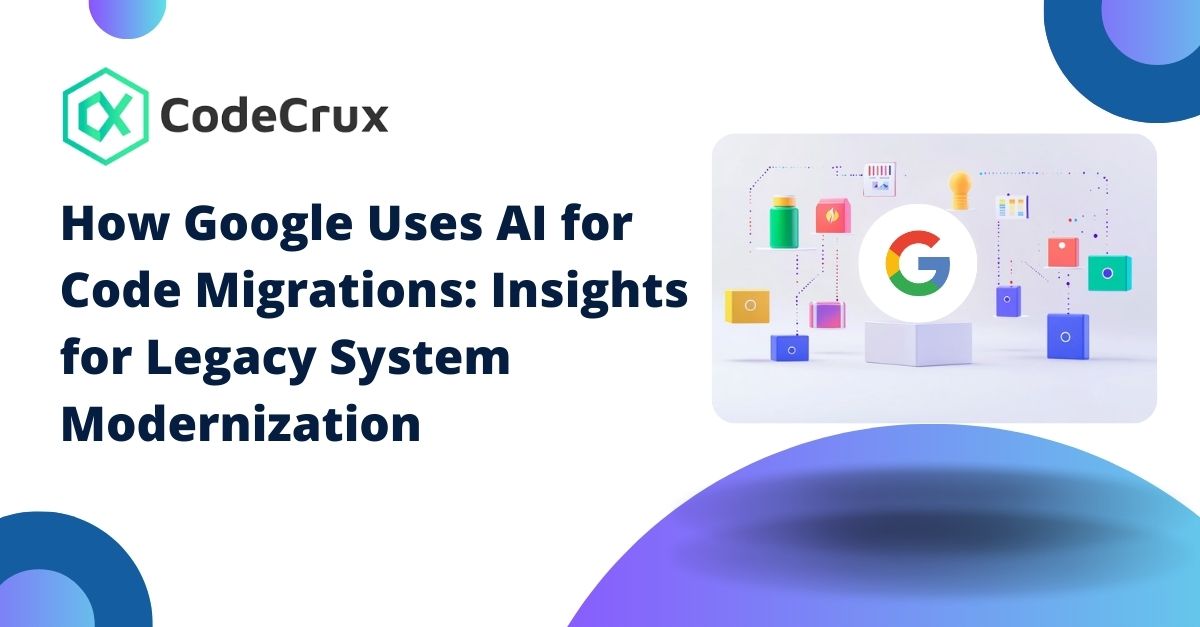How Google Uses AI for Code Migrations: Insights for Legacy System Modernization

Over the weekend, I delved into Google’s research paper on utilizing AI for internal code migrations, which is packed with fascinating insights into modernizing legacy systems. The strategies highlighted in the paper offer a comprehensive framework for addressing challenges related to outdated codebases, technical debt, and system upgrades. In this blog, I will explore these insights in detail and discuss how organizations can leverage similar approaches for modernization.
Google’s Innovative Approach to Legacy Modernization
1. Accelerating Legacy Modernization with AI
Google employs Large Language Models (LLMs) to automate large-scale code migrations, significantly reducing manual effort. For instance, Google’s Ads team faced the challenge of migrating over 500 million lines of code, including converting outdated frameworks like Joda Time to Java Time. By automating these migrations, Google was able to accelerate the process and overcome complexities that had previously stalled projects for years.
The lesson here is clear: AI, when applied correctly, can untangle intricate code dependencies, replace outdated APIs, and streamline system upgrades without requiring a massive team of engineers.
2. Hybrid Approach: AI Meets Engineering Tools
Google’s success lies in its hybrid approach, combining the predictive power of LLMs with Abstract Syntax Tree (AST)-based tools. While LLMs excel at handling ambiguous or complex transformations, AST-based tools provide deterministic accuracy, ensuring critical code structures remain intact.
This synergy of AI and engineering tools demonstrates the importance of building a reliable safety net when modernizing systems, especially for mission-critical applications where precision is paramount.
3. Reusable Migration Workflows
Google has developed modular workflows for its code migrations, enabling them to standardize and reuse processes across projects. By building a library of customizable tools and prompts for LLMs, they’ve streamlined recurring migration tasks such as:
1) Framework updates (e.g., JUnit3 to JUnit4)
2) API deprecations
3) Library migrations (e.g., Joda Time to Java Time)
These workflows allow teams to onboard new projects quickly and ensure consistent results across diverse product areas. Organizations facing frequent modernization challenges can benefit from adopting a similar toolkit approach to reduce overhead and enhance efficiency.
4. Measuring Success with Business-Centric Metrics
Rather than focusing on technical outputs like the volume of AI-generated code, Google measures the success of its migrations by their business impact. A key metric is the 50% reduction in project timelines, achieved through AI-driven automation.
This business-aligned approach ensures modernization projects contribute directly to organizational goals, such as improved system agility, enhanced user experience, and reduced operational costs.
5. Safe and Scalable Rollouts
Google emphasizes the importance of phased rollouts for AI-driven changes. This gradual deployment minimizes disruptions and ensures that critical systems remain stable during transitions. Additionally, rigorous testing and human oversight during each phase help mitigate risks.
For organizations handling complex migrations, this controlled rollout strategy provides a clear roadmap for balancing innovation with reliability.
6. Strategic Use of AI Models
Google employs a combination of custom fine-tuned AI models and general-purpose tools, tailoring their approach based on the complexity of the task. For instance:
1) Fine-tuned models are used for domain-specific migrations (e.g., Ads code migrations).
2) General-purpose models handle simpler, repetitive tasks across different teams.
This strategy provides flexibility and scalability, ensuring resources are allocated efficiently without compromising quality.
Applying Google’s Strategies to Legacy System Modernization
Here’s how organizations can implement Google’s approach to streamline their modernization efforts:
1. Leverage AI Tools
Utilize AI models like LLMs to automate tedious tasks such as:
1) Refactoring legacy code.
2) Replacing deprecated libraries.
3) Resolving dependencies.
These tools can dramatically reduce manual workloads and accelerate project timelines.
2. Adopt a Hybrid Approach
Combine AI-powered automation with engineering tools like ASTs to:
1) Ensure the accuracy of transformations.
2) Validate changes through static analysis.
3) Safeguard critical systems from errors.
3. Build Modular Workflows
Develop reusable workflows tailored to your organization’s modernization needs. For example:
1) Create scripts for common migration patterns.
2) Design prompts for AI tools that reflect your specific codebase.
4. Align with Business Goals
Define success metrics that focus on measurable business outcomes, such as:
1) Faster time-to-market.
2) Improved system performance.
3) Cost savings from reduced technical debt.
5. Plan for Phased Rollouts
Develop a roadmap for deploying AI-driven changes gradually. Include:
1) Rigorous testing phases.
2) Human reviews for high-risk updates.
3) Monitoring mechanisms to track stability and performance.
6. Tailor AI Models to Your Needs
Evaluate when to invest in custom fine-tuned models versus using off-the-shelf AI tools. For complex migrations, customized models can provide better accuracy and context.
Real-World Examples from Google
Google’s paper highlights several case studies that demonstrate the effectiveness of their approach:
1) JUnit3 to JUnit4 Migration: Google migrated 5,359 test files, modifying over 149,000 lines of code in just three months using their AI toolkit. This migration addressed long-standing technical debt and simplified future updates.
2) Joda Time to Java Time Migration: Tackling one of their largest migrations, Google used LLMs to replace outdated Joda Time APIs with Java Time. By clustering related changes and automating validation, they achieved significant time savings while ensuring code quality.
3) Experimental Flag Cleanup: Google’s AI-powered tools removed thousands of stale experimental flags, reducing technical debt and improving code maintainability.
Conclusion: The Future of Modernization with AI
Google’s innovative use of AI for code migrations provides a compelling blueprint for modernizing legacy systems. By combining AI-driven efficiency with engineering best practices, organizations can achieve:
1) Faster migrations.
2) Safer deployments.
3) Greater alignment with business goals.
Whether you’re facing outdated frameworks, complex dependencies, or technical debt, Google’s strategies offer actionable insights to tackle these challenges effectively. For a deeper understanding, I’ve attached the full research paper—let’s discuss how these ideas can be applied to your projects!
Click here to read Google.com white pager